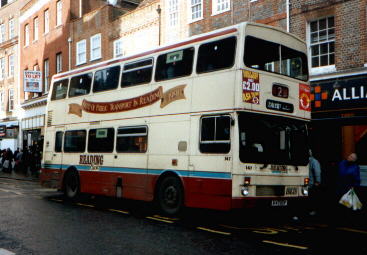Reading Transport - Deregulation 1980s & 90s
www.buszone.co.uk
The 1980 Transport Act introduced deregulation of coach services in the United Kingdom. The subsequent Transport Act 1985 introduced deregulated bus services, coming into effect on 26th October 1986.
The Transport Act of 1985 was created as a response to growing concern about the environmental effect that private (car) transportation was having and the public's objection to an increase in road construction, along with a desire to reduce the amount of public funding for bus services, provide better access to private funding and generate more committed management. This was achieved by allowing bus companies to determine what services they would operate on a self-sustaining basis (including routes and fares), and then local authorities to subsidise any other socially necessary services by competitive tender. Authorities were encouraged to dispose of any publically owned companies to help stimulate the privatised market, including the National Bus Company and municipal companies like Reading Transport. Only a very small number of municipal bus companies remained in public ownership following this process, and more have been sold since.
Reading Transport is one of the few remaining municipal companies, and was set up as a limited company on 26th October 1986, running at arms-length from it's shareholder Reading Borough Council. A "save our buses" campaign helped the company remain under Council ownership.
At this point the company had reached a degree of efficiency and standardisation with the entire network operated by relatively modern double deck vehicles. Dual doors were a standard feature from the delivery of Reading's first rear engine deckers (Bristol VRTs) in 1971 until the second generation of rear engine, lower emission, Optare Spectras in 1992. As with the rest of the industry during the late 1980s plans were developed to trial minibuses which commenced operations from June 1988 branded Goldrider, and single deckers were reintroduced in October 1989. The operator became committed to fuel technology and bus priority technology development, and with a very early experimenter with electronic tagging of buses to give priority at traffic lights and next stop announcement systems in the early 1990s. In 1992/3 four vehicles operated experimentally on BioDiesel, a fuel made from Oil Seed Rape, and in 1993/4 experiments with low sulphur diesel were carried out, a fuel that all the companies buses now use.
Increased awareness of customer related marketing (CRM) in the late 1980s and 1990s led to a number of experiments to decide on a new look and identity for the company, including on Leyland Titan 75 which received an experimental livery with a maroon skirt, maroon roof and upper deck window surrounds and a large expanse of cream in the middle. This culminated in the launch of the Reading Buses image and trading name in March 1991, and a return to the cream and burgundy colours used by the company from 1901 to 1971 applied to MCW Metrobus 164.
The 90th anniversary of the company in 1991 led to a series of bus rallies, and special branding being applied to MCW Metrobus Mk II 147:
The company's operating area expanded to serve the surrounding country areas and also into Newbury following the acquisition of the Reading and Newbury operations of The Bee Line in August 1992, which was the rebranded identity of the privatised Alder Valley North subsidiary of the National Bus Company (Alder Valley was formed when National Bus Company subsidiaries Aldershot & District Traction and Thames Valley Traction merged on 1 January 1972). With this came a fleet of non-standard vehicles, most of them elderly which contrasted with the newest buses in Reading's fleet which were are among the best specified vehicles available in the UK. Services were rapidly rebranded under either the Reading Buses identify or a new sister Newbury Buses identity for vehicles based at the acquired depot in Mill Lane, Newbury.
Reading Transport now consisted of several trading names; Reading Buses, Newbury Buses, Goldline Travel (see separate page), and Reading Transport Engineering for commercial engineering services (primarily vehicle recoveries).


Town services were strengthened further on 1st June 1998 with the take-over of Reading Mainline, an independent company that had started to compete against Reading Transport in 1994. This brought an influx of over 40 AEC Routemasters - the largest fleet outside London, although the operation was wound down and the vehicles replaced by July 2000. The Routemasters retained their Reading Mainline identity throughout, but with some joint publicity as the networks started to be merged.
In 1998 the company moved from it's historic depot in Mill Lane, which was originally built to house the town's fleet of trams. A new state of the art facility was opened at Great Knollys Street, allowing the riverside Mill Lane site to be redeveloped for The Oracle Shopping centre and a cinema. When the Reading operations moved to Great Knollys Street, two other depots were also in use, one at Kenavon Drive which came into the company's ownership with the takeover of The Bee Line's routes as was being used as a second engineering works alongside Mill Lane, and the other the base of Reading Mainline. Both depots were moved to the Great Knollys Street site once their leases could be terminated.
The late 1990s saw a period of consolidation, not helped by severe staff shortages and the need for significant investment in the fleet to replace inherited vehicles. This corresponded with the advert of low floor, easy access, vehicles which provided space for a wheelchair, with the first such vehicles (Optare Excels) entering service in February 1997. Just eleven years later, in March 2008, the last step entrance vehicles were withdrawn from the main network. The last step entrance vehicles (Optare Spectras 708-13) remained confined to dedicated school and football services until May 2013 when they were finally replaced.
After this comes: New Millennium
